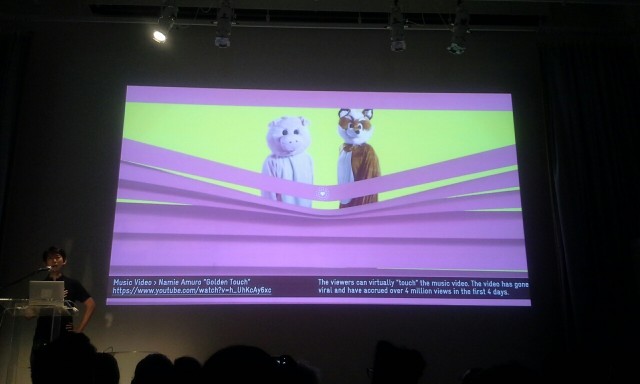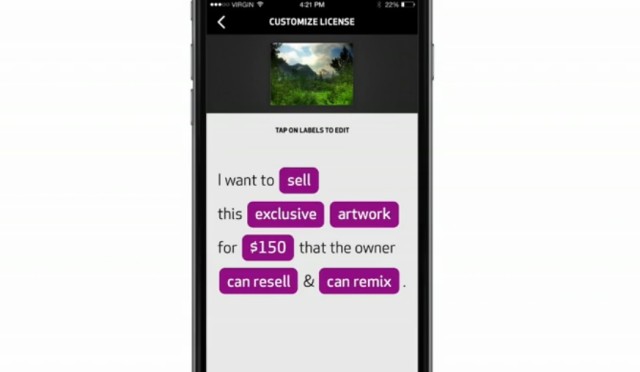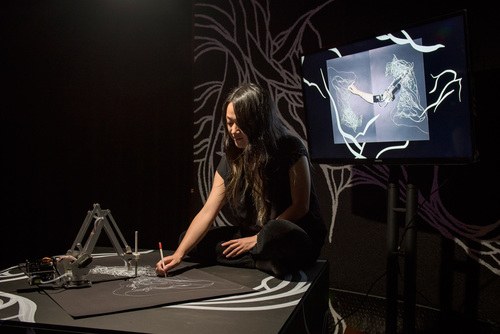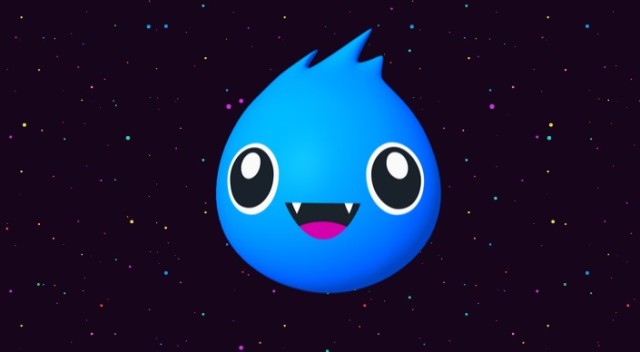
PARTY discusses their music video for Namie Amuro during NEW INC Demo Day.
When art mingles with tech, there can be a rush to mass-market artsy/techy products; in the early days of new tech, those products can sound terribly goofy, and they often aim at self-improvement. Take, for example, from 1969, artist Thomas Tadlock’s “Archetron,” a color synthesizer that turned black-and-white signals on a TV into colorful psychedelic imagery. It ended up being sold as a “prophecy, meditation, and healing machine” at a new age center in New York. That product never really caught on; and we tend to remember Tadlock more for his art contribution than a commercial one.
Now, we’re in another “early days” era dealing with new tech: post-desktop technologies like apps and wearables; community-generated tools like blockchain technology; and human-machine collaborations. At the July Demo Day for NEW INC—an offshoot of the New Museum that provides shared workspace and professional development to creatives across the fields of art, tech, and design—we heard how the incubator’s first-year residents, all 40-plus of them—are dealing with our new tech’s early days. The residents, who range from solo artists and technologists to small-scale corporations, gave five to ten-minute-long presentations in the New Museum’s theater on what they’ve done this past year. (An exhibition of residents’ work runs concurrently at Red Bull Studios New York.) The residents created apps (Specimen, Art Local, Generate, Aiko). They made easy-to-use creative tools (Better, NewHive, Monegraph). And like Thomas Tadlock before them, their art-and-tech research often resulted in product creation. At times, really colorful, really goofy product creation: Is the world of art and tech really such a cheery place focused on self-improvement?
Below, a couple of highlights from the 2015 Demo Day:

Demonstration of Monegraph‘s forthcoming app
Monegraph
In some cases, how the projects would be marketed and sold seemed like a far-off venture. Some of my favorite projects fell into this category; perhaps because they didn’t have that feeling of being rushed into product-hood.
Monegraph, which debuted as a project between Anil Dash and Kevin McCoy at Seven on Seven in 2014, has since turned into a tool whereby users can take control over their digital artwork from the get go. Artists can upload a work, price it, create an edition size, and set royalty fees, all within an app. The future of a work— where it’s located, who owns it—will be recorded in a public ledger using blockchain technology. Transparency.
I still have questions, which, of course, can’t really be addressed in a ten-to-fifteen-minute talk. Monegraph won’t launch until September; I’m curious to see which type of artists will use it. Will we see artists slowly usurp their dealers by gravitating to Monegraph, or we will we see a lot of amateurs putting up $25 GIFs for sale? In the long term, how can Monegraph assure its artists that the blockchain can track where a work lands in perpetuity? Again, plenty of questions to be answered with the product’s launch.

Still from Emilio Bianchic‘s NewHive, “Little Gendered Body Parts,” 2015.
NewHive
A website-making tool that I’ve already used, NewHive, lets you create standalone pages with text, GIFs, images, and audio. I haven’t spent a ton of time using it for my own projects, but it’s what I wish Livejournal had been when I was a kid, when I could’ve created the best art and audio scrapbooks. And, of course, it’s pretty great to use now, too, to create hybrid digital content: NewHive has invited dozens of artists (like Emilio Bianchic, whose NewHive we profiled yesterday) to produce pages, and teachers have developed lesson plans around the tool. Based on the presentation at NEW INC, there was no mention of how the group plans to monetize their product—maybe once the company narrows down its use? Based on personal use, I prefer using NewHive to PowerPoint; they could try taking over the click-through-presentation market.
Cotton Candy Theremin

It’s a cotton candy theremin! Image courtesy of the Creators Project.
Another trend at the NEW INC talks: highly saturated colors on cute everything.
On the whimsical side, we saw a pink-and-yellow cotton-candy machine with a theremin in it, accompanied by software-controlled visuals. It’s hard to gauge whether the world really needs a better way to eat cotton candy, but why tell that to a tinkerer? There’s a joy to be found in doing things just because (and not because you need to produce a commercially viable product). On stage, NEW INC’ers Philip Sierzega and Emilie Baltz, who paired up at NEW INC while seated at desks across from each other, discussed how they wanted to create a “sensorium” that pairs our sense of taste with that of sound and vision, to create a “collective, multi-sensory experience.” Both went on to discuss potential uses of the #cottoncandythermin, at a carnival, perhaps.
Oh, the bright colors! The flashing lights! The fun and games of a carnival. The New Museum basement is about as skeletal as conference rooms come, though many of the projects discussed took on a playful spirit (all daubed in neon, of course). I’m not knocking on that aesthetic; I wanted to download plenty of the most whimsical apps.
Aiko
Especially Anders Sander’s Aiko, a very cute teardrop with a toothy grin, a digital companion for the Apple Watch with some health-savviness thrown in for good measure; the more steps you take, the more upgrades you’re given to adorn your Aiko. Pretty much, it’s a Tamagotchi for the Fitbit generation. After Sanders showed us a variety of digital wigs to choose from for Aiko, I realized that you’re really just turning your pet into a drag queen. A-plus for unsuspecting subversion.
But with all this shiny cutesy-ness swirling around, I was left wondering whether there was any room left for boring, serious, or even sad uses for technology. (Not that this never occurs: Deep Lab, a feminist hacking collective, stayed at NEW INC this spring in a one-week residency, so I’m going to count hacking as a “serious” project.)
Even when it comes to the choice of design color for NEW INC products, I wondered if anyone would be down with black and white. (Demo Day made me feel like being stuck inside Candy Crush.) When I think of a net-art aesthetic of the 1990s, that’s what I think of—black and white, or 8-bit color. In the 2000s, Internet blue becomes dominant; it’s the the default hyperlink setting, or the sky behind the rolling hills in “Bliss,” the Windows startup background as of 2002.
Doug

“Drawing Operations Unit: Generation_1 (D.O.U.G)” an installation by Sougwen Chung at Red Bull Studios New York. Image courtesy of Red Bull.
One project that stood out, particularly for its simplicity, was Sougwen Chung’s drawing machine.
Hers was more like an old-fashioned art and tech collaboration—the type I would have expected to see at E.A.T. in the 1960s—rather than a product-based one. Sougwen Chung, along with Yotam Mann, created “Doug,” a plain, metal robotic arm that mimics whatever Chung draws. Doug is still a baby, and requires Chung’s feedback in order to learn her style. His gestures are still shaky. If nothing else, it’s humbling to see this human-non-human feedback loop, especially in comparison to current Hollywood examples which have gone wild with sentient A.I. storylines: Ex Machina, Avengers: Age of Ultron, or C.H.A.P.P.I.E., to name just a couple of films from this year alone.



Comments on this entry are closed.